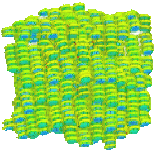|
|
|
|
|
|
Scientific background
Liquid crystals, colloids and polymers comprise a large number of fascinating states of soft condensed matter of great interest in the last decades. In liquid crystals the orientational order of the constituent molecules is associated with a reduced or absent translational order. This combination of properties confers on liquid crystalline systems a combination of fluidity and easy alignment in external fields as well as anisotropic properties, similar to those of a crystal, that are the basis of their many technological applications in displays or other electro-optical devices.
Colloid science concerns the study of systems involving small particles of one substance suspended in another. Suspensions in liquids form the basis of a wide variety of systems of scientific and technological importance, including paints, ceramics, cosmetics, agricultural sprays, detergents, soils, biological cells, etc.
An understanding of the macroscopic properties of complex systems, their phase transitions and their many strange and interesting behaviour patterns in terms of molecular models can only be attained using computer simulations, possibly with the complement of approximate statistical mechanical theories. Computer simulations are particularly interesting and timely now because of their very rapid development and wide reach. While simulations of liquid crystals are based on the same general Monte Carlo and Molecular Dynamics techniques used for simple fluids, they present a number of problems and peculiarities connected with the intrinsic properties of liquid crystals such as their long-range order and their anisotropy. This requires in turn the development of suitable algorithms to calculate static properties such as order parameters, correlation functions, elastic constants and in general tensorial observables as well as dynamic quantities such as diffusion tensors, viscosities, susceptivities etc . It is now also becoming possible to examine topological defects characteristic of the various liquid crystals and to investigate their core structure and even to perform direct microscopic level simulations of simple devices and displays. Another series of problems is connected to the need of predicting the properties of liquid crystals from molecular models.
For the computer simulations of colloids and polymers several methods are currently available, but each field has developed its own set of tools and specialized procedures. It is however increasingly clear that a forum for discussing the relation and potential cross-fertilization between these connected areas would be very desirable. Moreover a number of experimental systems exist or are being developed like, e.g. polymer liquid crystals or anisotropic gels where the different fields necessarily merge.
From a more technical, but not less important point of view, the application of simulation methods to complex fluids requires on one hand developing of force fields for modeling the essential molecular features of mesogens, and the other performing large scale simulations, with a number of particles often an order of magnitude greater than those used in simple fluid simulations. This in turn requires exploiting state of the art resources in computing, and particularly parallel computing
|
|
|
|
|


